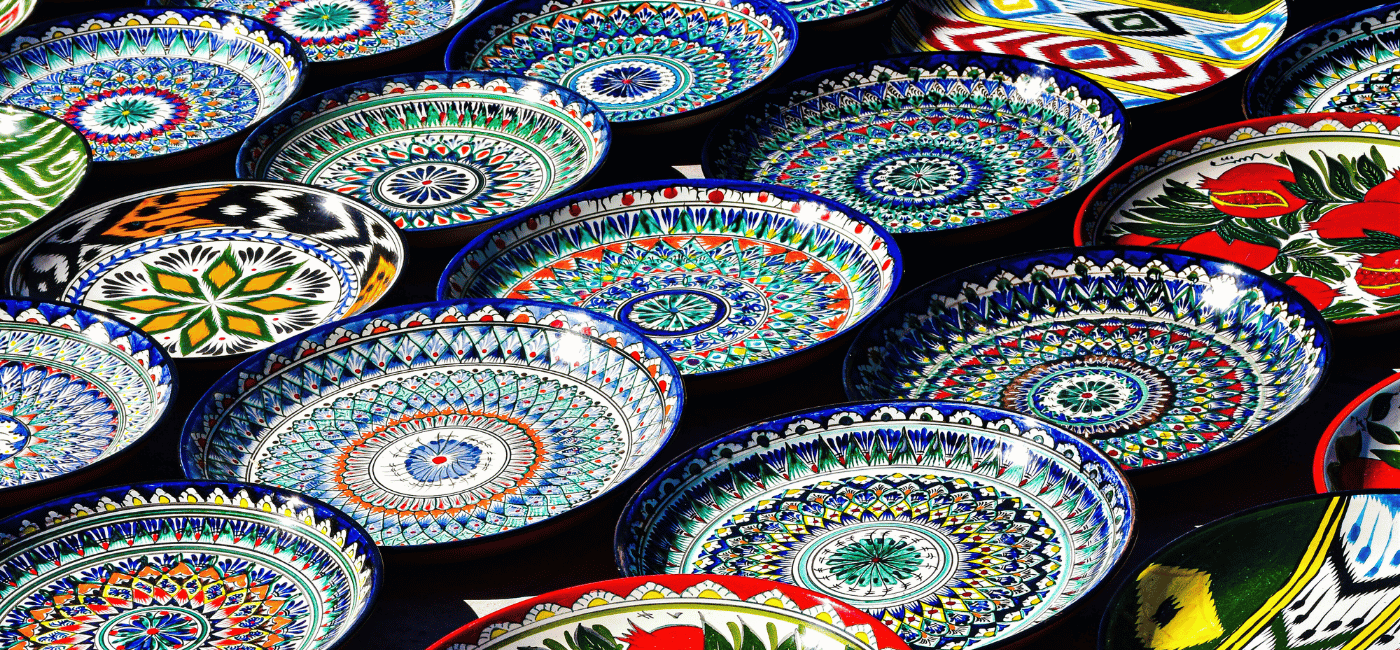Ceramic Art in Uzbekistan

Uzbekistan Ceramic Art
Uzbekistan has a rich and vibrant tradition of ceramic art, dating back over a thousand years. Known for its intricate patterns, bold colors, and unique regional styles, Uzbek ceramics have played a significant role in Central Asian culture, trade, and daily life. The craft has been passed down through generations, with master artisans preserving ancient techniques while adding contemporary touches.
History and Cultural Significance
Ceramic production in Uzbekistan flourished along the Great Silk Road, where local artisans exchanged techniques and designs with cultures from China, Persia, and the Middle East. The art form has been deeply connected to architecture, homeware, and religious artifacts, adorning mosques, palaces, and traditional Uzbek homes.
Uzbek pottery is not just decorative; it reflects spiritual beliefs, cultural identity, and historical narratives. Each region has developed its own signature style, making Uzbek ceramics instantly recognizable and highly valued worldwide.
Famous Centers of Uzbek Ceramic Art
1. Rishtan - The Capital of Uzbek Ceramics
- Rishtan, located in the Fergana Valley, is the most famous center of Uzbek ceramic production.
- Known for its distinctive blue and turquoise glazes, created using local natural minerals.
- Designs feature floral patterns, arabesques, and geometric motifs, reflecting Islamic and Persian influences.
- The signature "ishkor" glaze gives Rishtan ceramics their deep, rich colors and glossy finish.
2. Gijduvan - The Land of Earthy Tones
- Gijduvan, in the Bukhara region, is home to the renowned Narzullaev family, who have preserved ceramic traditions for generations.
- Unlike Rishtan, Gijduvan ceramics use warm, earthy tones like yellow, brown, and green, often combined with bold geometric patterns.
- The pottery is heavier and more textured, making it ideal for both decorative and practical use.
3. Khiva - Delicate Simplicity
- Khiva’s ceramic art is influenced by the ornamental tilework of its historic old city.
- Muted colors with simple, symmetrical patterns distinguish Khiva pottery.
- Traditionally used for decorative tiles, bowls, and plates, often seen in historical buildings.
4. Samarkand & Bukhara - A Fusion of Styles
- These cities blend Persian, Mongol, and Central Asian influences in their ceramic designs.
- Samarkand ceramics feature bright, floral motifs, while Bukhara is known for its golden hues and elegant compositions.
- Both regions specialize in tilework, which adorns famous monuments like the Registan and Kalyan Mosque.
Production Process of Uzbek Ceramics
Uzbek ceramic-making is a multi-step process that requires high levels of skill and patience.
1. Clay Preparation
- High-quality clay is sourced from local deposits and mixed with water.
- The clay is kneaded and left to rest to improve its elasticity.
2. Shaping the Pottery
- The clay is hand-molded or shaped on a potter’s wheel into bowls, plates, jugs, and decorative tiles.
- Artisans use traditional wooden tools to refine details and create smooth surfaces.
3. Drying and First Firing
- The shaped ceramics are air-dried for several days before undergoing the first firing in a kiln.
- The temperature varies depending on the clay type and the intended glaze.
4. Hand-Painting and Glazing
- After the first firing, artists hand-paint intricate designs using natural mineral pigments.
- A special glaze, often made from quartz, ash, and metal oxides, is applied to create a glossy, waterproof finish.
5. Second Firing
- The glazed ceramics are fired again at a high temperature (900–1000°C), locking in the vibrant colors and giving the pieces their signature shine.
Symbolism and Patterns in Uzbek Ceramics
Uzbek ceramics are rich in symbolic meanings, often inspired by nature, spirituality, and folklore. Some common motifs include:
- Floral & Vine Patterns – Represent growth, prosperity, and harmony.
- Geometric Designs – Symbolize order, infinity, and unity in Islamic art.
- Birds & Animals – Often depict freedom, protection, and good fortune.
- Sun & Stars – Associated with light, wisdom, and divine guidance.
Modern Revival and Global Recognition
Despite industrialization, Uzbek ceramic art remains highly valued worldwide. Many local workshops and master potters continue producing authentic, handmade ceramics, while modern artists are blending traditional styles with contemporary designs.
- Uzbek ceramics are showcased in international exhibitions and museums.
- Tourists and collectors seek out authentic handmade pieces in local bazaars, art galleries, and online stores.
- Government initiatives and UNESCO support have helped preserve and promote Uzbekistan’s rich ceramic heritage.
Where to Buy Authentic Uzbek Ceramics?
If you’re looking to purchase genuine Uzbek ceramics, the best places to explore include:
- Rishtan & Gijduvan Ceramic Workshops – Visit local masters and see the pottery-making process firsthand.
- Tashkent’s Chorsu Bazaar – A famous market offering handmade ceramics, textiles, and crafts.
- Bukhara & Samarkand Art Galleries – Many historic cities have specialized craft stores and museums selling authentic pieces.
- Online Stores & Exhibitions – Many artisans now sell their work through global e-commerce platforms.
Conclusion
Uzbekistan’s ceramic art is a testament to the country’s rich cultural heritage and artistic excellence. Each handcrafted piece reflects centuries-old traditions, masterful craftsmanship, and deep symbolic meaning. Whether you are a collector, traveler, or admirer of fine art, Uzbek ceramics offer a timeless blend of history, beauty, and craftsmanship.
To experience the magic of Uzbek pottery, visit the workshops of Rishtan, Gijduvan, and Bukhara, or explore local bazaars where these vibrant, handcrafted treasures are waiting to be discovered.
Related topics:

